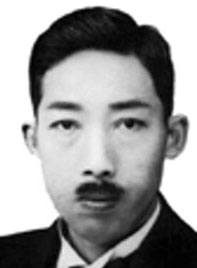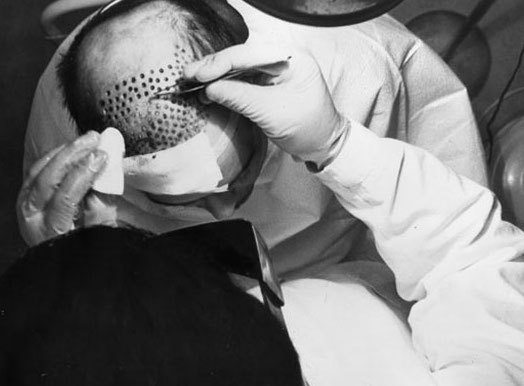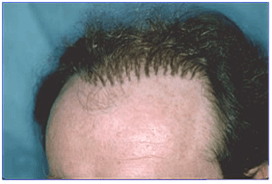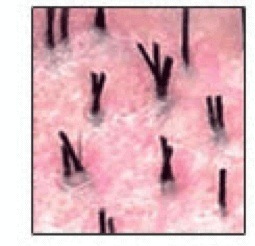Hair Transplant History
Hair transplantation as a science has evolved over the years and has been perfected as new techniques have been invented and updated. The first attempts at transplanting both human and animal hair were made in the 18th and 19th centuries. However, it is difficult to find any concrete evidence of hair transplant results that exist from this time period.
1930s – Early Days

Modern day hair transplant surgery originated in Japan in the late 1930s. Dr. Okuda, who was a Japanese dermatologist, developed a process that was designed to address hair loss for those patients suffering from scalp injuries as well as hair loss suffered by burn victims. His hair transplant method was a “punch technique” where small sections of hair-bearing skin were placed into small holes where the skin had been damaged. The areas where the grafts were placed would heal and produce hair in the damaged skin areas.
As groundbreaking as these early innovations were for the art of hair transplants, they occurred during the World War II time period and were not available in the United States for many years.
1950s – Hair Transplants Arrive in New York

In the early 1950s, a New York dermatologist, Dr. Norman Orentreich, performed the first hair transplant that was designed specifically to treat male pattern baldness. The doctor not only completed the transplant but he also established that hair on the back and sides of a male scalp is not susceptible to balding. When the hairs from those areas were relocated, they remained resistant to balding regardless of being transplanted to another section of the body. He also coined the phrase “donor dominance” to explain this concept.
The hair graft contained 20-30 hairs in a round patch removed from the scalp. Dr. Orentreich’s 4.0-mm punch graft method remained the basic procedure used for hair transplant by surgeons until 1975.

One common criticism of early hair transplant punch graft methods was the general perception by the public that the results of hair transplants looked unnatural in appearance. The look was commonly referred to as “doll’s hair”, or having a “pluggy appearance”, thanks to the large grafts created by the method of using a round punch to harvest the donor hair.
The 80s and Beyond – The End Of Punch Grafts
The 1980s saw a major leap forward in the evolution of hair transplant methods. Large punch grafts were replaced by a hair restoration technique where larger strips of hair were removed from the area of the scalp resistant to balding. These larger strips of hair were trimmed to create mini-grafts (that provided a greater fullness to the hair) and micrografts (that gave a more refined hairline in the front). This method also helped to reduce the amount of scarring that occurred on the head of the patient.

The 90s saw even more hair transplant advances with the introduction of FUT (Follicular Unit Transplantation). This technique allows the hair of a patient to be transplanted in a naturally occurring group of 1-4 hairs (the follicular units). These units contain hair follicles, oil glands, nerves and (sometimes) fine vellus hairs. These small units allow the hair transplant surgeon to safely transport thousands of hair grafts in a single session which maximizes the cosmetic impact of the procedure. (1)
The art of performing FUT (Follicular Unit Transplantation) was refined even further in 2003 with the performance of the first FUE surgery. FUE (Follicular Unit Extraction) allows individual hair follicles to be removed from the donor area. They are transplanted to the balding area without causing any type of linear scar on the scalp.
Looking To The Future For You
FUE Transplant Evolution
FUE has been on the rise in the last decade to the point that many leading hair transplant centers do not routinely offer strip FUT anymore. The International Society of Hair Restoration created a FUE Research Committee, with some of the leading names in performing FUE procedures, in 2012. The goal of this committee was to find the best methods that make FUE work as well as perform research to standardize the procedure. Dr. Mohebi was the first chairman of the FUE Research Committee for the first two years. The hard work of the investigators in this committee changed everything. FUE procedures were developed to become more efficient with minimal complications in the field of hair restoration. The trend has moved more towards FUE every year since the formation of the committee.
Is there any room for strip FUT procedures or is FUE is the new gold standard of hair restoration? We think there is still room for FUT for some special cases. Have you been researching hair restoration methods and are still not sure which technique is the best?
We will be happy to schedule a consultation appointment with you to determine the best hair transplant procedure for your specific hair restoration needs.
Is Robotic Hair Transplant the answer?

In recent years, the hair transplant field has seen advances such as Robotic FUE System (ARTAS). The Robotic Hair Restoration Concept has been around for over a decade but the Robots made it to the market a few years ago for harvesting hair. Despite the initial promise that it would be the future of hair restoration, the desire to get a robotic hair restoration died due to the lack of versatility and slow advancement of the robotic system in comparison to other devices used for hair restoration.
Multiphasic Hair Extraction
Multiphasic FUE systems such as Trivellini System can help extract the grafts more efficiently. They help improve the final results drastically while making the extraction and placement of a larger number of grafts in one day possible.
There are many innovations in the field of hair restoration, in both existing and new devices, that can make the process of hair restoration surgery more efficient in the future.
Beard and Body to Scalp Hair Transplant
Beard and Body to Scalp Transplants has been around for many years but the use of new and more effective devices to harvest hair, such as Trivellini Multiphasic System, allows for the extraction of hair from virtually anywhere on the body with a minimal risk of losing any of those hair follicles in the process. Body and beard hair transplantation has increased the total available follicles to be transplanted for people who suffer from advanced classes of hair loss.
Multiphasic Hair Extraction
Multiphasic FUE systems, such as Trivellini System, can help extract the grafts more efficiently. They improve the final results drastically while also making it possible to extract and place a larger number of grafts in one day.
There are many innovations in the field of hair restoration, in both existing and new devices, that can make the process of hair restoration surgery more efficient in the future.
Hair Transplants with Almost No Downtime
The technology of hair restoration, and our improved understanding of the FUE procedure, has empowered us to transplant a larger number of grafts in each session while keeping the procedure discreet. Celebrity Hair Transplant™ by Dr. Parsa Mohebi was invented to respond to the needs of our California patients to have a procedure with almost no downtime. There are many patients who are constantly in front of the public and it is critical for them to be able to restore their hair without shaving or anything else that makes the procedure detectable. Celebrity Hair Transplant™ by Dr. Parsa Mohebi has evolved to the point that Parsa Mohebi Hair Restoration can offer hair restoration procedures with over 1500 grafts per day. This seems to be the trend of the future since we see more patients inquire about this novel technique on a daily basis.
These advanced hair restoration techniques provide a natural look while also minimizing the downtime that results from undergoing a hair transplant procedure.
Hair Multiplication for Hair Restoration
This topic has been one of the most common questions we have received in the last decade. People ask:
When we can restore our hair through hair cloning or hair multiplication?
Unfortunately, the answer has not changed over the last few years. We believe this technology will not be a reality in the next 8-10 years. Despite the initial pilot studies, no one has started the research on phase three for this method which will be used to prove its long-term efficacy and safety.
While it is hard to predict the future of hair transplant technology, there is one thing that is easy to predict. The staff at Parsa Mohebi Hair Restoration will continue to be pioneers in the latest hair restoration techniques. Our goal is to help you achieve the look (both inside and out) you’ve always dreamed of for yourself.
(1) Orentreich N: Autografts in alopecias and other selected dermatological conditions. Annals of the New York Academy of Sciences 83:463-479, 1959.